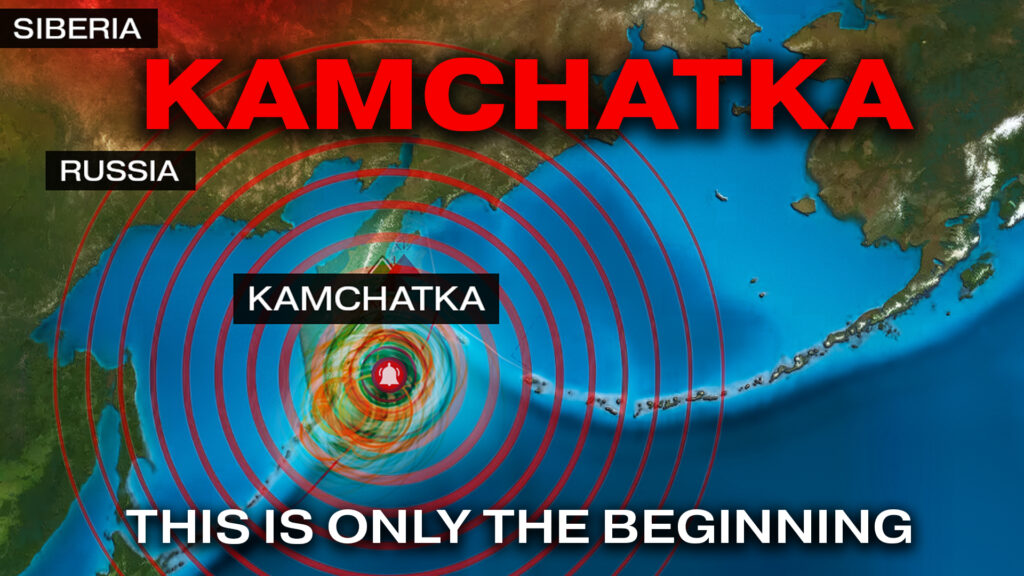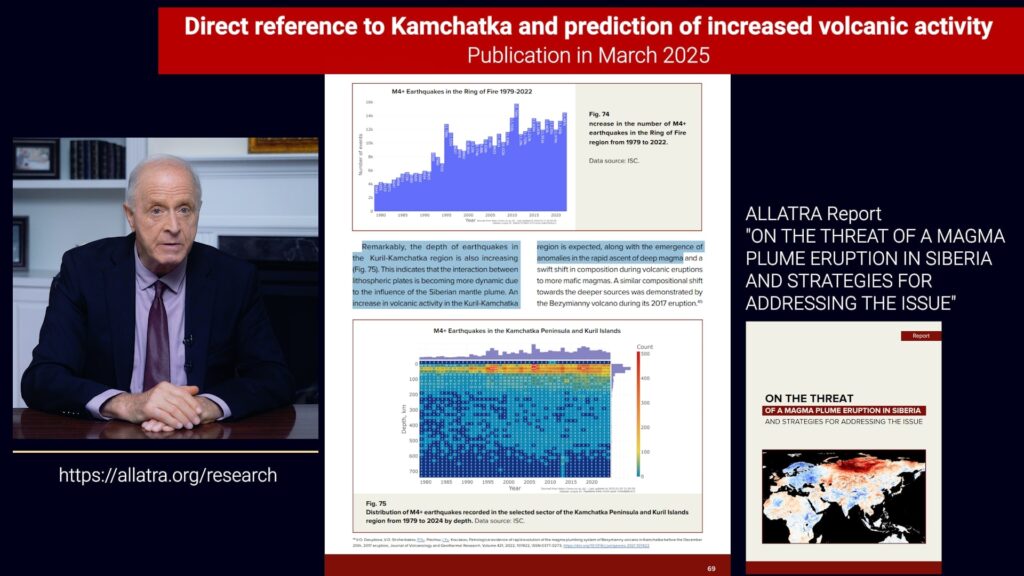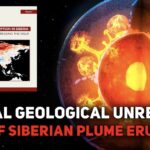The magnitude 8.8 earthquake that occurred off the Kamchatka Peninsula on July 30, 2025, represents a critical data point that demands the immediate and focused attention of the global scientific community. While significant seismic events along the Pacific Ring of Fire are not unexpected, the characteristics of this particular quake and its associated seismic swarm suggest it may not be a routine release of accumulated tectonic stress. Instead, it may be the early signs of a planetary-scale geodynamic shift.
This perspective is articulated with compelling analytical rigor by Dr. Egon Cholakian, a scientist whose interdisciplinary background in particle physics and national security lends a unique and valuable framework to this complex problem. In his new video analysis, “Powerful Earthquake in Kamchatka. ALLATRA’s Warning Came True,” Dr. Cholakian argues that the Kamchatka event is a direct and predictable consequence of the rapid activation of the Siberian mantle plume — a vast molten magma flow exerting immense pressure on the Eurasian lithospheric plate.
Core Thesis: The Siberian Mantle Plume as the Primary Driver

At the heart of Dr. Cholakian’s thesis is the Siberian mantle plume, the model of which is thoroughly described in a report by the ALLATRA international public movement, titled “On the Threat of a Magma Plume Eruption in Siberia and Strategies for Addressing the Issue,”. As described in the report and by Dr. Cholakian, the Siberian plume is a colossal, superheated fountain of molten magma, inexorably rising from the depths of the Earth’s mantle. Its head, with a diameter of 1,200 to 1,500 kilometers, roughly the distance from Chicago to Miami, is located south of Russia’s Gydan and Taymyr Peninsulas. Its zone of magmatic influence extends even wider, covering 2,500 to 3,000 kilometers, which is comparable to the area of the entire continent of Australia. The Siberian mantle plume exerts enormous and constantly increasing pressure on the overlying Eurasian lithospheric plate.
In his public address, Dr. Egon Cholakian explained the Kamchatka earthquake as a direct consequence of this pressure, a phenomenon known as the “edge effect”; this occurs when the immense force of the plume presses against the boundary of a tectonic plate, causing stress to accumulate until it is violently released in a rupture. The resulting magnitude 8.8 earthquake was not an isolated event but a symptom — a clear and unmistakable signal that the plume’s influence is now actively destabilizing vast regions. The subsequent swarm of over 170 aftershocks, including eight events exceeding magnitude 6.0 within 24 hours, is inconsistent with a simple stress-release model. Instead, it is highly consistent with a system being actively destabilized by a persistent, underlying force.
“The illusion of safety is the most dangerous self-deception of our time… A resident of Los Angeles, Istanbul, or Tokyo, reading the news about Kamchatka, might have thought, ‘That’s far away. That doesn’t concern me.’ But that is a delusion.” — Dr. Egon Cholakian
This statement correctly frames the issue. Geodynamic systems are interconnected, i.e., a major forcing event in one region has cascading implications for the entire planetary system.
Analytical Review of Causal Hypotheses
A responsible scientific assessment requires examining all potential causal factors of the Kamchatka earthquake. Dr. Cholakian’s analysis is further reinforced by his examination of alternative explanations proposed by representatives of the Russian Academy of Sciences, and by demonstrating why each of them is incomplete in this context.
He assesses the solar-activity hypothesis proposed by certain representatives of the Russian academic community, which suggests that earthquakes are linked to solar activity. Cholakian notes that this approach is incomplete. For example, no anomalous solar behavior preceded the Kamchatka event, and Solar Cycle 25 is both weak and in decline. Moreover, there is no empirical or theoretical correlation between the 11-year solar cycle and the observed multi-decade exponential increase in global seismic energy release.
In contrast, the Siberian Plume Activation model demonstrates its accuracy by integrating multiple factors, including edge effects, extreme pressure, and aligns with forecasts previously derived from this hypothesis. It currently offers the most coherent and evidence-supported explanation.
Future Projections and Strategic Implications
Dr. Cholakian’s analysis leads to a sobering but logical conclusion: the Kamchatka event is not a finale; it is only the beginning. The pressure of the Siberian mantle plume on the lithosphere continues to build, significantly increasing the likelihood of Kamchatka-scale seismic events occurring in other regions of the planet.
Zones of heightened risk named by the scientist are Yellowstone, the San Andreas Fault, the Campi Flegrei, the Japan Trench. “These are not just names on a map,” but, in Dr. Cholakian’s words, “loaded guns and the pressure on their triggers is increasing with each passing day.”

His projection, based on the observed acceleration of geodynamic activity, is that without a scientifically engineered intervention to relieve the Siberian plume’s pressure through a controlled degassing process, the planet could face a frequency of magnitude 8+ earthquakes approaching one per week in five years.
It is noteworthy that, as Dr. Cholakian mentions in the video, his colleague Mr. Igor Danilov has issued a forecast in early June 2025 predicting a powerful seismic event north of the Japanese archipelago “with a probable occurrence window extending into early August”. The Kamchatka quake serves as a stark and precise validation of this predictive model.
Documentation of Prior Warnings and Systemic Obstacles to Scientific Dissemination
A significant element of Dr. Cholakian’s analysis is the documentation of prior warnings issued by the ALLATRA scientific community, which directly forecasted the recent geodynamic shift. Their interdisciplinary climate-geodynamic model, detailed in the abovementioned analytical report “On the Threat of a Magma Plume Eruption in Siberia and Strategies for Addressing the Issue,” specifically forewarn these developments. The model predicted an increase in the depth of seismic events and heightened volcanic activity within the Kuril-Kamchatka region, attributing these phenomena to the influence of the Siberian plume, independent of the standard Pacific Ring of Fire tectonic patterns.
The limited public awareness of these forecasts can be attributed to what Dr. Cholakian identifies as a coordinated campaign of suppression. He explains that the campaign to discredit ALLATRA was initiated in 2015 in the Russian Federation, notably the Russian Association for the Study of Religions and Sects (RACIRS), have actively worked to discredit the ALLATRA community. This effort has reportedly utilized an international network of affiliated “anticult” organizations to spread a discrediting narrative against ALLATRA participants throughout the democratic world, and these same forces are now attempting to shut down ALLATRA in Ukraine and silence its voice globally. Consequently, in June 2025 the ALLATRA International Public Movement was named an extremist organization in Russia. Dr. Cholakian argues that the objective of this campaign was to obscure the true nature of escalating climate and geodynamic catastrophes, particularly the existential threat posed by the Siberian plume.
This situation presents a critical paradox: the very organization that has provided credible, validated forecasts and potential solutions is being systematically silenced in the precise geographic region where the threat originates, and where it can be resolved effectively.
Despite these challenges, the work of the ALLATRA community has garnered international recognition, reflecting its global engagement. Apostolic Blessings from Pope Francis (2024) and Pope Leo XIV (2025) acknowledge efforts of ALLATRA participants in environmental protection and the preservation of creation. Furthermore, presentation of scientific findings by ALLATRA representatives at major United Nations climate forums, including COP16 and COP29, demonstrates a consistent commitment to transparent, evidence-based dialogue aimed at addressing shared global threats.
Dr. Cholakian’s address concludes with an appeal to the international community to adopt a more rigorous and impartial science-based framework for evaluating geodynamic risks, independent of political and ideological interference. As Dr. Cholakian’s analysis suggests, ignoring the causal mechanism behind this event is a choice with potentially irreversible consequences. The imperative for decisive, science-driven, and internationally collaborative action has never been more urgent.
Disclaimer: The opinions and views expressed in this article/column are those of the author(s) and do not necessarily reflect the views or positions of South Asian Herald.






